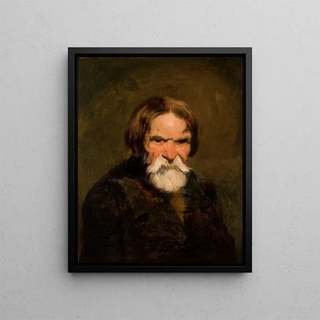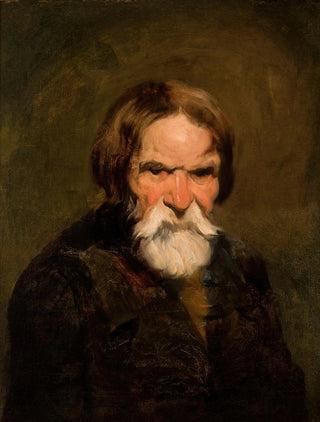Art print | Study of a bearded peasant - Piotr Michałowski


View from behind

Frame (optional)
Piotr Michałowski’s "Study of a Bearded Peasant" art print is rooted in a rich artistic tradition, where portraiture becomes a mirror of the human soul. This piece, both intimate and universal, immerses us in the life of a man whose face, marked by the years, tells a story. Michałowski, a 19th-century Polish painter, manages to capture not only the physical features of his model but also the very essence of his existence. The depth of the gaze, the texture of the beards, and the nuances of light and shadow invite us to contemplate the beauty of everyday life while revealing the complexity of human emotions.
Style and uniqueness of the art print
In "Study of a Bearded Peasant," Michałowski’s style stands out for its striking realism. Every detail is carefully observed, every shadow is applied with precision, giving the painting an almost tangible dimension. The choice of colors, both earthy and vibrant, evokes the ruggedness of peasant life while celebrating the dignity of its subject. The peasant’s posture, both stoic and vulnerable, echoes a pictorial tradition that values the worker, while highlighting the humanity behind stereotypes. This art print does not merely depict an individual; it elevates the peasant to an almost heroic status, placing him at the heart of a reflection on the human condition.
The artist and his influence
Piotr Michałowski, born in 1800, is an emblematic figure of Polish art, whose career is marked by an unceasing quest for artistic truth. Trained at the Academy of Fine Arts in Warsaw, he absorbed European influences while remaining deeply rooted in his cultural identity. His work reflects a time of great change, when art began to emancipate itself from academic conventions to explore more personal and social themes. Michałowski had a significant influence on his contemporaries, notably by popularizing realistic portraiture in Poland. His ability to depict daily life with such sensitivity paved the way for many artists who

Matte finish

View from behind

Frame (optional)
Piotr Michałowski’s "Study of a Bearded Peasant" art print is rooted in a rich artistic tradition, where portraiture becomes a mirror of the human soul. This piece, both intimate and universal, immerses us in the life of a man whose face, marked by the years, tells a story. Michałowski, a 19th-century Polish painter, manages to capture not only the physical features of his model but also the very essence of his existence. The depth of the gaze, the texture of the beards, and the nuances of light and shadow invite us to contemplate the beauty of everyday life while revealing the complexity of human emotions.
Style and uniqueness of the art print
In "Study of a Bearded Peasant," Michałowski’s style stands out for its striking realism. Every detail is carefully observed, every shadow is applied with precision, giving the painting an almost tangible dimension. The choice of colors, both earthy and vibrant, evokes the ruggedness of peasant life while celebrating the dignity of its subject. The peasant’s posture, both stoic and vulnerable, echoes a pictorial tradition that values the worker, while highlighting the humanity behind stereotypes. This art print does not merely depict an individual; it elevates the peasant to an almost heroic status, placing him at the heart of a reflection on the human condition.
The artist and his influence
Piotr Michałowski, born in 1800, is an emblematic figure of Polish art, whose career is marked by an unceasing quest for artistic truth. Trained at the Academy of Fine Arts in Warsaw, he absorbed European influences while remaining deeply rooted in his cultural identity. His work reflects a time of great change, when art began to emancipate itself from academic conventions to explore more personal and social themes. Michałowski had a significant influence on his contemporaries, notably by popularizing realistic portraiture in Poland. His ability to depict daily life with such sensitivity paved the way for many artists who






